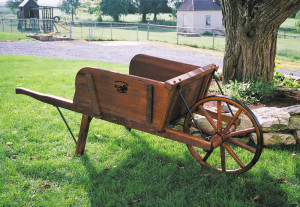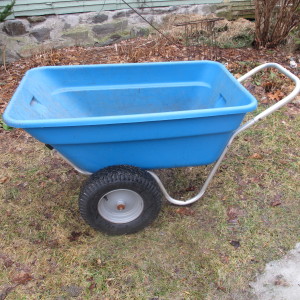Wheelbarrows
Thinking about writing a memoir, I recently pawed through my late mother’s journal from 1948. I was amazed to read that on my second birthday my sister, Ruth Anne, herself just four and a half, gave me a wheelbarrow, my first. My parents gave me a watering can. My Uncle Ralph and Auntie Ruth gave me a shovel.
With gifts like those, is it a surprise that I turned out to be a gardening guy? Or that I now own 7 kinds of wheelbarrows, uncountable hand tools and several watering cans? Spring is just around the corner and this might be a good time to look over the necessities for the upcoming gardening season.
One of my first memories in life is being in the garden with my grandfather when a quick thunderstorm approached. Grampy scooped me up, placed me on a pile of weeds in his wooden wheelbarrow, and we raced back to his old farmhouse. I loved that wheelbarrow.
Many years later I searched for a company making wooden wheelbarrows and found Spring Valley Woodworking in Gordonville PA run by Ike Lapp, who is Old Order Amish. I’ve met Ike and purchased one of his barrows. It has removable sides, which is nice for lugging fence posts, and a steel-rimmed wooden wheel that never goes flat. It even makes the same squeak my grandfather’s wheelbarrow made all those years ago.
To reach Ike and order a barrow, leave a message for him at 717-355-9366. He can’t have a phone in his home or workplace, but has a plywood shack with an answering machine in the middle of a field. He will return your call at his convenience, not yours. Maybe we should all be more like that.
My sturdiest wheelbarrow, the one I go to most often is called a Smart Cart (www.shopmullerscarts.com). It is great for heavy and bulky loads. The axle is centered under the load so that it feels light to the touch and turns easily on its two wide 16-inch diameter wheels. It has a tubular aluminum frame and a big plastic bin (7 cubic feet).
You can easily remove the bin from the frame so that you can wash the dog in it, or carry compost in the back of your car. My model (with wide wheels) is rated for 600 lbs; the wire wheel version is rated for 400 lbs. There is also a 12-cubic foot bin that is interchangeable with the 7-foot bin, though I’ve never seen it.
Everything about this cart is well designed. It’s more expensive than a standard wheelbarrow, but worth it. I’ve kept mine outdoors all summer for years without problems. I visited the web site and see that there are now 2 grades of carts: contractor (original) and a less expensive residential grade, which I have not tested.
Then there is the standard old-fashioned one-wheeled wheelbarrow in either metal or plastic. I have a metal one, but have had a plastic one, too. The metal ones are better for heavy loads, but do rust over time. Generally they have wooden handles that are replaceable – though you shouldn’t have to. Their biggest advantage is that they can turn on a dime and will go down a narrow path in the garden – something 2-wheeled barrows generally cannot do. They come in two sizes: 6- and 4-cubic foot varieties. I have the larger one.
I also have a plywood garden cart. The original brand, often called a Garden Way cart, is made by Carts Vermont (www.cartsvermont.com) though other companies now make them. These come in 2 sizes: Mid-size (6.5 cu feet) and large (13.6 cubic feet), which I have. These are great for carrying bulky loads like hay and leaves. They use 26-inch bicycle tires, but offer a solid tire as an option – which I wish I had. Avoiding flat tires would be great.
Then there is my folding aluminum wheelbarrow. It is the Tipke 2100 folding cart (www.tipkemfg.com/foldit), and is remarkably sturdy. It has removable sides like my grandfather’s cart but its main claim to fame is that it folds up – and weighs just 33 pounds. If you are an apartment dweller, you can store it in a closet; it will fit in a small car to go to the community garden, but it can carry up to 330 lbs.
There are also electric powered wheelbarrows that can assist you in getting up a long incline with a heavy load. A rechargeable 24 volt battery is the standard power source. I tried one a few years ago, but the motor and battery add weight and cost, so I was not interested. I’ve seen several brands on-line.
I’ve also tried the cheap plastic wheelbarrows with plastic wheels. They cost well under $100 at big box stores, and are worth even less. I wouldn’t have one, but I suppose if you are just beginning and on a restricted budget, one might do the job for a few years.
When possible, I recommend buying wheelbarrows after trying one out. So go to your local feed-and-grain store or garden center and test drive one. Do it now, before you get too busy in the garden.
Henry lives and gardens in Cornish Flat, NH. His website is www.Gardening-Guy.com.
Early Spring Chores
Spring finally seems to be coming to Cornish Flat – about a month late, this year. My snowdrops are just starting to bloom and large patches of snow are still on the lawn and garden – though there are bare spots. I really want to get outside and start cleaning up the yard and garden beds, but will try to hold myself back until things have dried out.
Why is it important to wait before doing much gardening? It’s all about soil structure. Soil is made up of ground rock, organic matter and air spaces. The mineral component is about 45%, organic matter can be from 1% to 10% or more, and the rest consists of air spaces. That last component is as important as the first two.
Plant roots that we can see when we dig up a weed or plant a shrub are only a part of the entire root. The parts of the root that absorbs water, oxygen and minerals are so fine that we cannot see them. They are called root hairs, but they are even finer than human hair, microscopically fine. And there are lots of them. Most plants have branch roots that spread out and branch again and again. Root hairs are short protuberances attached to those branching roots. But fine roots cannot push through packed soil as easily as through fluffy soil. The total length of root tissues in a single rye plant is around 380 miles.
As you know, if you walk on soggy lawn you leave foot prints. That means that you have squeezed air out of the soil and compacted it – making it all the harder for roots and root hairs to extend and thrive. Not only that, green plants get their oxygen from the soil via their roots. If the oxygen is squeezed out, plants can’t get it.
So what can a gardener do? Wait. Don’t walk on your lawn if you see footprints or hear a squish. Don’t rake winter debris from the lawn while the lawn is still dormant. If you do, you risk pulling up the grass, roots and all. And stay out of flower beds even later into the spring – they are more susceptible to compaction than your lawn.
So what can you do in early April? Clean and sharpen your tools, including the handles. I have a potato hoe, a 5-tined rake-like tool that has been in my family for over 50 years. It has its original wood handle, which is still in perfect condition – even though I use it for weeding and soil prep every week, often every day, all summer. How is that possible? I try to oil the handle every year either in the fall or the early spring. And I don’t leave the tool outside in the sun or rain. No matter how tired I am at the end of the day I walk the potato hoe back to the barn before I go to the house.
To clean up a wooden handle, first I use fine steel wool (or a green scrubbie) to polish up the handle and remove any rough spots. Then I apply a coat of boiled linseed oil with a brush or rag. I let it soak in for a few hours, then rub off any excess. Or if the oil soaks right in, I might even apply a second coat. The steel tines I clean with steel wool and apply a light coat of sewing machine oil.
This year I need to oil the wood on my wooden wheel barrow and tighten up all the bolts. One of my first memories in my life is of my Grampy picking me up, plunking me down in his wooden wheelbarrow on a pile of weeds, and racing us back to the barn ahead of a fast-approaching thunderstorm. I might have been just two years old. The ride was bumpy – there was a steel-rimmed wooden wheel – but it was exciting!
Unfortunately that wooden wheelbarrow disappeared after Grampy went off to the great garden in the sky. But many years later I tracked down an Amish woodworker in Pennsylvania, Ike Lapp, who still makes wooden wheelbarrows and got myself one. It’s pretty much the same wheelbarrow I remember my grandfather using. When I finished assembling it I pushed it across the lawn for a test drive and it made the same squeak that my grandfather’s wheelbarrow did.
I called Ike Lapp at his home in Gordonville, PA recently. He is old order Amish, so does not have a phone in his house or workshop. Instead he has a phone and answering machine in a separate 4-foot square building in a field. (He checks messages once a day and calls customers back. He’s at 717-355-9366 717-355-9366). He told me he is still making the wheelbarrows and in addition to mine, a large premium grade wheelbarrow for around $300, he has smaller ones, and some in “rustic grade”. He does not have a web site, but you can see his wheelbarrows at www.lehmans.com.
717-355-9366). He told me he is still making the wheelbarrows and in addition to mine, a large premium grade wheelbarrow for around $300, he has smaller ones, and some in “rustic grade”. He does not have a web site, but you can see his wheelbarrows at www.lehmans.com.
Later, when your ground has dried out and you are raking and weeding flower beds, try to reach in with your rake, keeping your feet out of the beds. If you must walk in flower beds, bring along a couple of short planks. Place them in the flower bed and step on the boards to distribute your weight. Or if you are not worried about what the neighbors will say, you could wear your snowshoes. After the winter we’ve had, that seems appropriate!
Henry Homeyer is a gardening consultant and the author of 4 gardening books. His web site is www.Gardening-Guy.com.





